MITSUBISHI COLT 2008 Owner's Manual (in English)
Manufacturer: MITSUBISHI, Model Year: 2008, Model line: COLT, Model: MITSUBISHI COLT 2008Pages: 450, PDF Size: 14.57 MB
Page 341 of 450
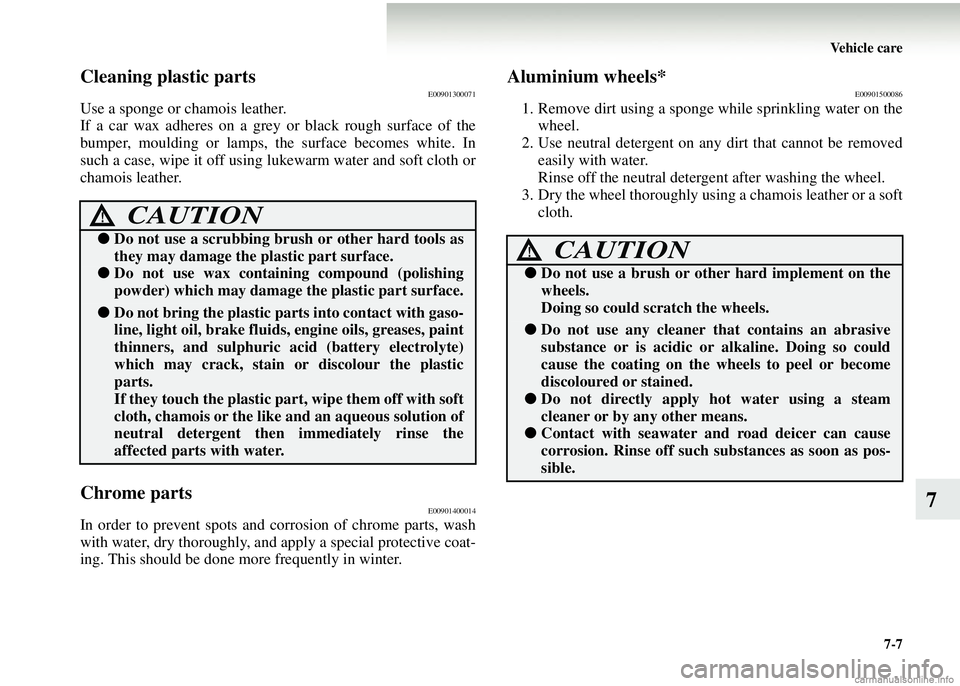
Vehicle care7-7
7
Cleaning plastic partsE00901300071
Use a sponge or chamois leather.
If a car wax adheres on a grey or black rough surface of the
bumper, moulding or lamps, the surface becomes white. In
such a case, wipe it off using lukewarm water and soft cloth or
chamois leather.
Chrome partsE00901400014
In order to prevent spots and corrosion of chrome parts, wash
with water, dry thoroughly, and apply a special protective coat-
ing. This should be done more frequently in winter.
Aluminium wheels*E00901500086
1. Remove dirt using a sponge while sprinkling water on the wheel.
2. Use neutral detergent on any dirt that cannot be removed
easily with water.
Rinse off the neutral detergent after washing the wheel.
3. Dry the wheel thoroughly using a chamois leather or a soft
cloth.
CAUTION!
● Do not use a scrubbing brush or other hard tools as
they may damage the plastic part surface.
●Do not use wax containing compound (polishing
powder) which may damage the plastic part surface.
●Do not bring the plastic parts into contact with gaso-
line, light oil, brake fluids, engine oils, greases, paint
thinners, and sulphuric ac id (battery electrolyte)
which may crack, stain or discolour the plastic
parts.
If they touch the plastic pa rt, wipe them off with soft
cloth, chamois or the like and an aqueous solution of
neutral detergent then immediately rinse the
affected parts with water.
CAUTION!
● Do not use a brush or other hard implement on the
wheels.
Doing so could scratch the wheels.
●Do not use any cleaner th at contains an abrasive
substance or is acidic or alkaline. Doing so could
cause the coating on the wheels to peel or become
discoloured or stained.
● Do not directly apply hot water using a steam
cleaner or by any other means.
●Contact with seawater an d road deicer can cause
corrosion. Rinse off such su bstances as soon as pos-
sible.
Page 342 of 450
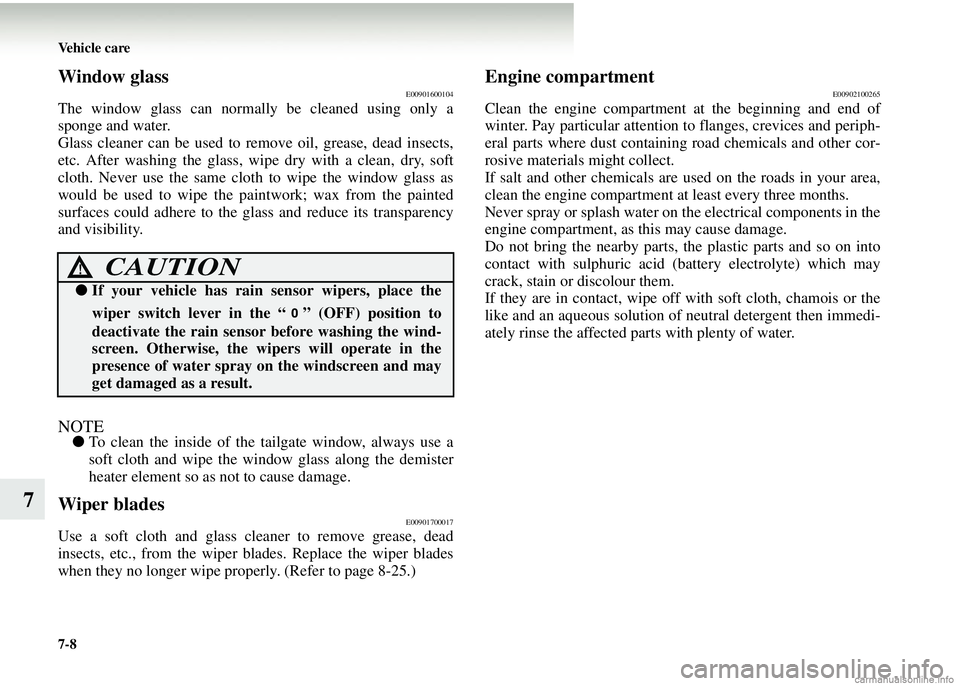
7-8 Vehicle care
7
Window glassE00901600104
The window glass can normally be cleaned using only a
sponge and water.
Glass cleaner can be used to re move oil, grease, dead insects,
etc. After washing the glass, wi pe dry with a clean, dry, soft
cloth. Never use the same cloth to wipe the window glass as
would be used to wipe the paintwork; wax from the painted
surfaces could adhere to the gl ass and reduce its transparency
and visibility.
NOTE● To clean the inside of the tailgate window, always use a
soft cloth and wipe the window glass along the demister
heater element so as not to cause damage.
Wiper bladesE00901700017
Use a soft cloth and glass cleaner to remove grease, dead
insects, etc., from the wiper blades. Replace the wiper blades
when they no longer wipe properly. (Refer to page 8-25.)
Engine compartmentE00902100265
Clean the engine compartment at the beginning and end of
winter. Pay particular attention to flanges, crevices and periph-
eral parts where dust containing road chemicals and other cor-
rosive materials might collect.
If salt and other chemicals ar e used on the roads in your area,
clean the engine compartment at least every three months.
Never spray or splash water on the electrical components in the
engine compartment, as this may cause damage.
Do not bring the nearby parts, the plastic parts and so on into
contact with sulphuric acid (bat tery electrolyte) which may
crack, stain or discolour them.
If they are in contact, wipe off with soft cloth, chamois or the
like and an aqueous solution of neutral detergent then immedi-
ately rinse the affected pa rts with plenty of water.
CAUTION!
●If your vehicle has rain sensor wipers, place the
wiper switch lever in th e “ ” (OFF) position to
deactivate the rain sensor before washing the wind-
screen. Otherwise, the wip ers will operate in the
presence of water spray on the windscreen and may
get damaged as a result.
Page 343 of 450
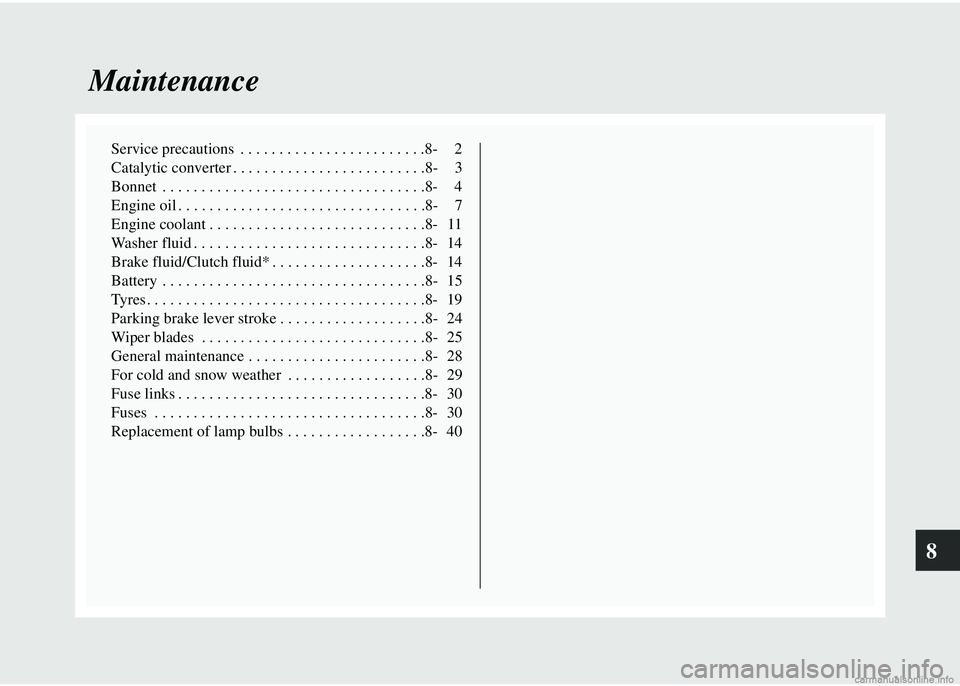
8
Maintenance
Service precautions . . . . . . . . . . . . . . . . . . . . . . . .8- 2
Catalytic converter . . . . . . . . . . . . . . . . . . . . . . . . .8- 3
Bonnet . . . . . . . . . . . . . . . . . . . . . . . . . . . . . . . . . .8- 4
Engine oil . . . . . . . . . . . . . . . . . . . . . . . . . . . . . . . .8- 7
Engine coolant . . . . . . . . . . . . . . . . . . . . . . . . . . . .8- 11
Washer fluid . . . . . . . . . . . . . . . . . . . . . . . . . . . . . .8- 14
Brake fluid/Clutch fluid* . . . . . . . . . . . . . . . . . . . .8- 14
Battery . . . . . . . . . . . . . . . . . . . . . . . . . . . . . . . . . .8- 15
Tyres . . . . . . . . . . . . . . . . . . . . . . . . . . . . . . . . . . . .8- 19
Parking brake lever stroke . . . . . . . . . . . . . . . . . . .8- 24
Wiper blades . . . . . . . . . . . . . . . . . . . . . . . . . . . . .8- 25
General maintenance . . . . . . . . . . . . . . . . . . . . . . .8- 28
For cold and snow weather . . . . . . . . . . . . . . . . . .8- 29
Fuse links . . . . . . . . . . . . . . . . . . . . . . . . . . . . . . . .8- 30
Fuses . . . . . . . . . . . . . . . . . . . . . . . . . . . . . . . . . . .8- 30
Replacement of lamp bulbs . . . . . . . . . . . . . . . . . .8- 40
Page 344 of 450
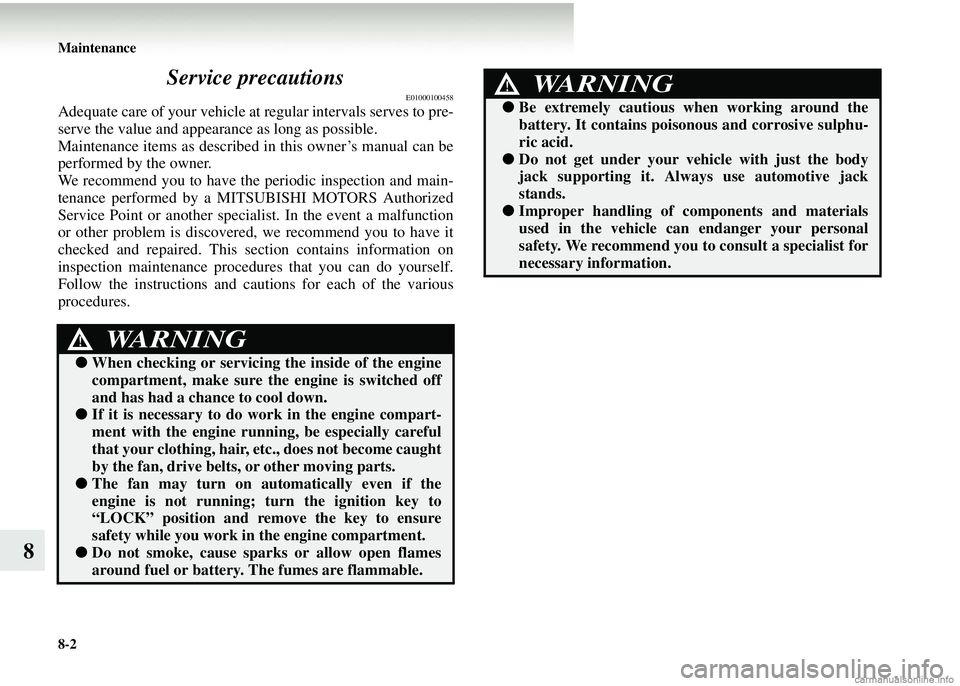
8-2 Maintenance
8Service precautions
E01000100458
Adequate care of your vehicle at
regular intervals serves to pre-
serve the value and appear ance as long as possible.
Maintenance items as described in this owner’s manual can be
performed by the owner.
We recommend you to have the periodic inspection and main-
tenance performed by a MITS UBISHI MOTORS Authorized
Service Point or another specialist. In the event a malfunction
or other problem is discovered, we recommend you to have it
checked and repaired. This section contains information on
inspection maintenance procedures that you can do yourself.
Follow the instructions and cautions for each of the various
procedures.
WARNING!
● When checking or servicing the inside of the engine
compartment, make sure th e engine is switched off
and has had a chan ce to cool down.
●If it is necessary to do work in the engine compart-
ment with the engine runni ng, be especially careful
that your clothing, hair, et c., does not become caught
by the fan, drive belts, or other moving parts.
● The fan may turn on automatically even if the
engine is not running; turn the ignition key to
“LOCK” position and remove the key to ensure
safety while you work in the engine compartment.
●Do not smoke, cause sparks or allow open flames
around fuel or battery. The fumes are flammable.
●Be extremely cautious wh en working around the
battery. It contains poison ous and corrosive sulphu-
ric acid.
● Do not get under your vehicle with just the body
jack supporting it. Always use automotive jack
stands.
●Improper handling of comp onents and materials
used in the vehicle can endanger your personal
safety. We recommend you to consult a specialist for
necessary information.
WARNING!
Page 345 of 450
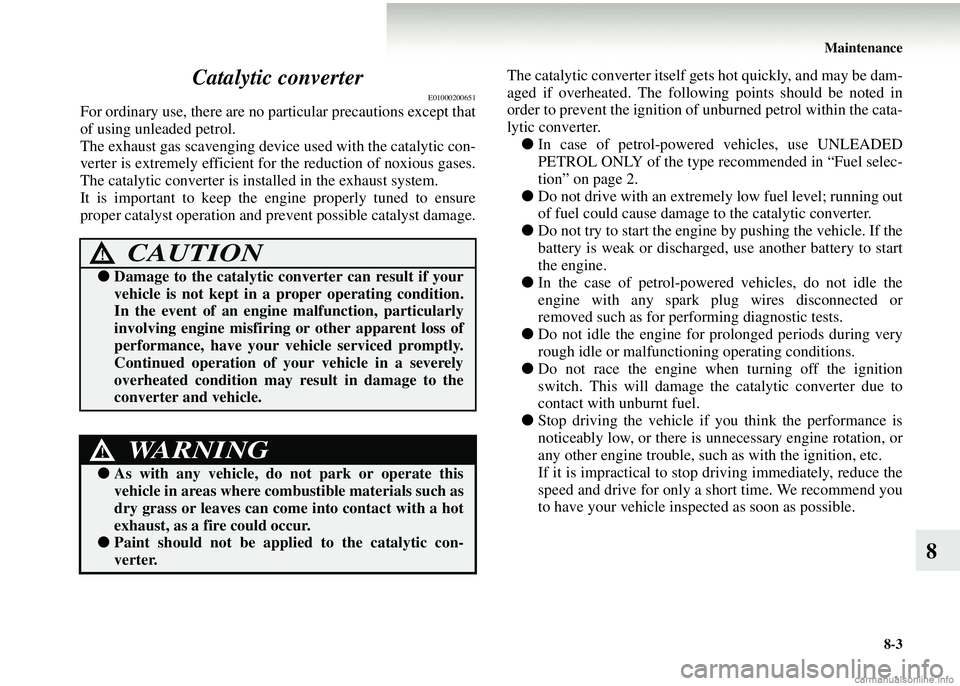
Maintenance8-3
8
Catalytic converter
E01000200651
For ordinary use, there are no
particular precautions except that
of using unleaded petrol.
The exhaust gas scavenging device used with the catalytic con-
verter is extremely ef ficient for the reduction of noxious gases.
The catalytic converter is inst alled in the exhaust system.
It is important to keep the engine properly tuned to ensure
proper catalyst operation and prevent po ssible catalyst damage. The catalytic converter itself gets hot quickly, and may be dam-
aged if overheated. The followi
ng points should be noted in
order to prevent the ignition of unburned petrol within the cata-
lytic converter. ● In case of petrol-powered vehicles, use UNLEADED
PETROL ONLY of the type recommended in “Fuel selec-
tion” on page 2.
● Do not drive with an extremely low fuel level; running out
of fuel could cause damage to the catalytic converter.
● Do not try to start the engine by pushing the vehicle. If the
battery is weak or discharged, use another battery to start
the engine.
● In the case of petrol-powered vehicles, do not idle the
engine with any spark plug wires disconnected or
removed such as for performing diagnostic tests.
● Do not idle the engine for prolonged periods during very
rough idle or malfunctioning operating conditions.
● Do not race the engine when turning off the ignition
switch. This will damage the catalytic converter due to
contact with unburnt fuel.
● Stop driving the vehicle if you think the performance is
noticeably low, or there is un necessary engine rotation, or
any other engine trouble, such as with the ignition, etc.
If it is impractical to stop driving immediately, reduce the
speed and drive for only a s hort time. We recommend you
to have your vehicle inspected as soon as possible.
CAUTION!
● Damage to the catalytic co nverter can result if your
vehicle is not kept in a proper operating condition.
In the event of an engine malfunction, particularly
involving engine misfiring or other apparent loss of
performance, have your vehicle serviced promptly.
Continued operation of your vehicle in a severely
overheated condition may re sult in damage to the
converter and vehicle.
WARNING!
● As with any vehicle, do not park or operate this
vehicle in areas where combustible materials such as
dry grass or leaves can come into contact with a hot
exhaust, as a fire could occur.
●Paint should not be applied to the catalytic con-
verter.
Page 346 of 450
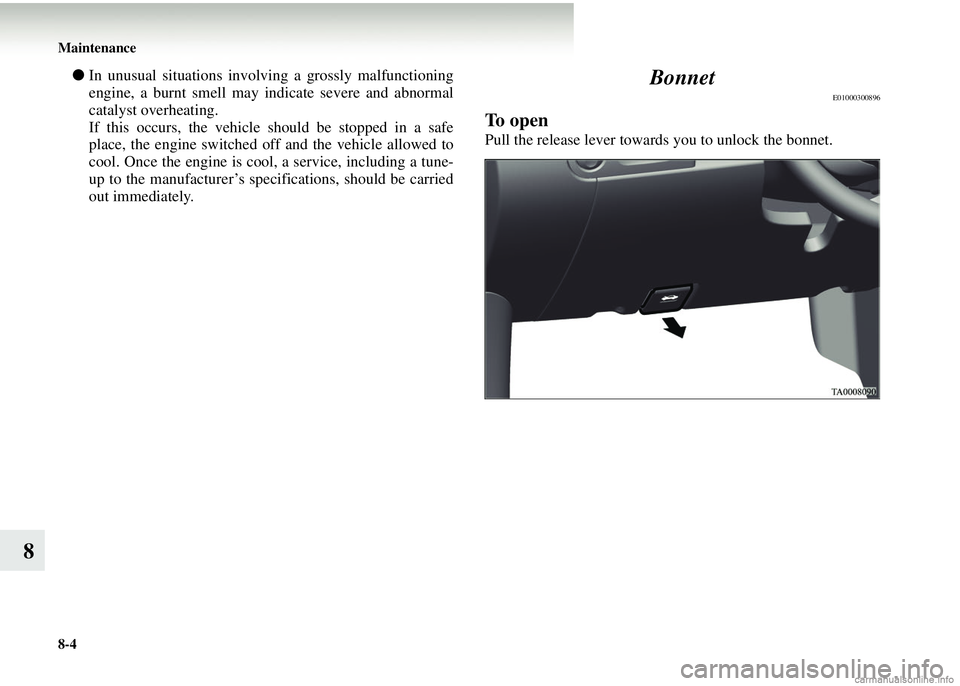
8-4 Maintenance
8
●In unusual situations involving a grossly malfunctioning
engine, a burnt smell may indicate severe and abnormal
catalyst overheating.
If this occurs, the vehicle should be stopped in a safe
place, the engine switched off and the vehicle allowed to
cool. Once the engine is cool, a service, including a tune-
up to the manufacturer’s sp ecifications, should be carried
out immediately.Bonnet
E01000300896
To open
Pull the release lever towards you to unlock the bonnet.
Page 347 of 450
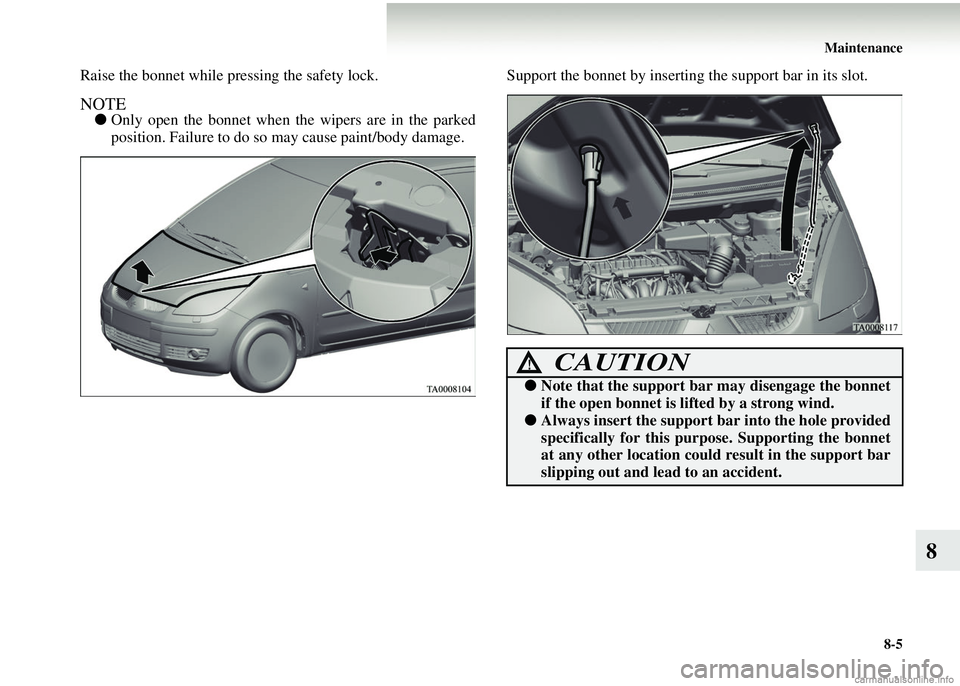
Maintenance8-5
8
Raise the bonnet while pr essing the safety lock.
NOTE●Only open the bonnet when the wipers are in the parked
position. Failure to do so may cause paint/body damage. Support the bonnet by inserting the support bar in its slot.
CAUTION!
●
Note that the support bar may disengage the bonnet
if the open bonnet is lifted by a strong wind.
●Always insert the support bar into the hole provided
specifically for this purpose. Supporting the bonnet
at any other location could result in the support bar
slipping out and lead to an accident.
Page 348 of 450
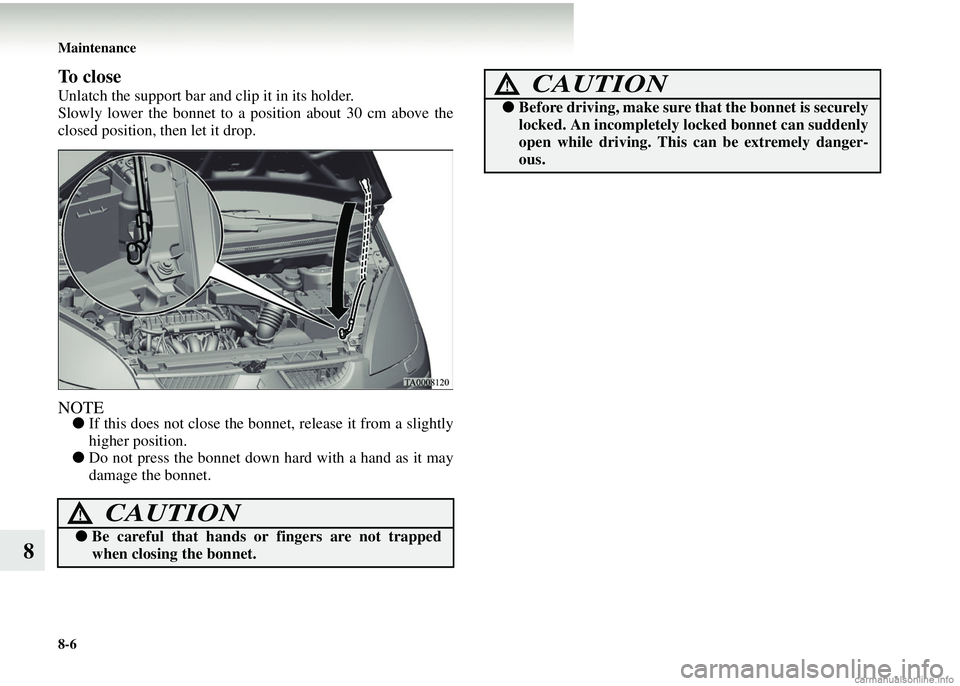
8-6 Maintenance
8
To close
Unlatch the support bar and clip it in its holder.
Slowly lower the bonnet to a position about 30 cm above the
closed position, then let it drop.
NOTE●If this does not close the bo nnet, release it from a slightly
higher position.
● Do not press the bonnet down hard with a hand as it may
damage the bonnet.
CAUTION!
●Be careful that hands or fingers are not trapped
when closing the bonnet.
●Before driving, make sure that the bonnet is securely
locked. An incompletely lo cked bonnet can suddenly
open while driving. This can be extremely danger-
ous.
CAUTION!
Page 349 of 450
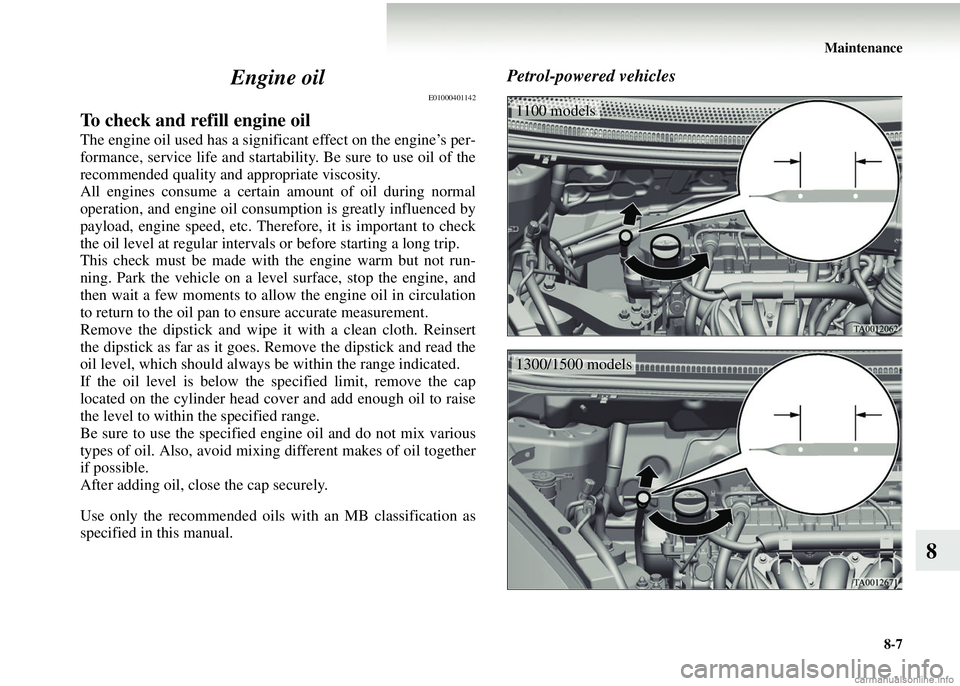
Maintenance8-7
8
Engine oil
E01000401142
To check and refill engine oil
The engine oil used has a significant effect on the engine’s per-
formance, service life and startability. Be sure to use oil of the
recommended quality and
appropriate viscosity.
All engines consume a certain amount of oil during normal
operation, and engine oil consumption is greatly influenced by
payload, engine speed, etc. Ther efore, it is important to check
the oil level at regular intervals or before starting a long trip.
This check must be made with the engine warm but not run-
ning. Park the vehicle on a level surface, stop the engine, and
then wait a few moments to allow the engine oil in circulation
to return to the oil pan to ensure accurate measurement.
Remove the dipstick and wipe it with a clean cloth. Reinsert
the dipstick as far as it goes. Remove the dipstick and read the
oil level, which should always be within the range indicated.
If the oil level is below the specified limit, remove the cap
located on the cylinder head cover and add enough oil to raise
the level to within the specified range.
Be sure to use the specified e ngine oil and do not mix various
types of oil. Also, avoid mixing different makes of oil together
if possible.
After adding oil, cl ose the cap securely.
Use only the recommended oils with an MB classification as
specified in this manual.
Petrol-powered vehicles
1100 models
1300/1500 models
Page 350 of 450
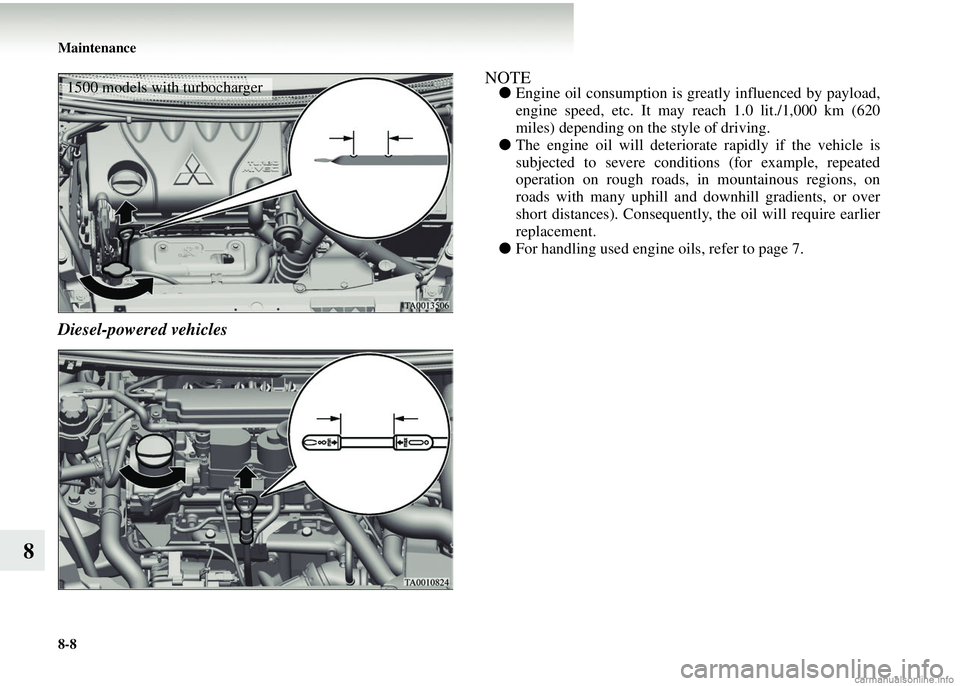
8-8 Maintenance
8
Diesel-powered vehicles
NOTE●Engine oil consumption is greatly influenced by payload,
engine speed, etc. It may reach 1.0 lit./1,000 km (620
miles) depending on the style of driving.
● The engine oil will deteriorate rapidly if the vehicle is
subjected to severe conditions (for example, repeated
operation on rough roads, in mountainous regions, on
roads with many uphill and downhill gradients, or over
short distances). Consequently, the oil will require earlier
replacement.
● For handling used engine oils, refer to page 7.1500 models with turbocharger